 How to draw an arc between two coordinate points in Google Maps like in this image and same like facebook post in iOS ?
How to draw an arc between two coordinate points in Google Maps like in this image and same like facebook post in iOS ?
- 507
- 1
- 14
- 27
-
Why do you want a arc if I may ask? Don't you want your user to see where he has to go instead of a arc – Tomm Oct 25 '17 at 13:54
-
2look at this link http://nshipster.com/mkgeodesicpolyline/ might get some help – Gagan_iOS Oct 25 '17 at 13:56
-
@Tomm This is to show origin and destination in Google maps only with network or flight dotted line. – Karthik Mandava Oct 25 '17 at 13:56
-
@KarthikMandava did you find a solution for this? – Haris Hussain Dec 23 '17 at 02:13
-
@HarisHussain not yet. – Karthik Mandava Dec 26 '17 at 13:15
6 Answers
Before using the below function, don't forget to import GoogleMaps Credits: xomena
func drawArcPolyline(startLocation: CLLocationCoordinate2D?, endLocation: CLLocationCoordinate2D?) {
if let startLocation = startLocation, let endLocation = endLocation {
//swap the startLocation & endLocation if you want to reverse the direction of polyline arc formed.
let mapView = GMSMapView()
let path = GMSMutablePath()
path.add(startLocation)
path.add(endLocation)
// Curve Line
let k: Double = 0.2 //try between 0.5 to 0.2 for better results that suits you
let d = GMSGeometryDistance(startLocation, endLocation)
let h = GMSGeometryHeading(startLocation, endLocation)
//Midpoint position
let p = GMSGeometryOffset(startLocation, d * 0.5, h)
//Apply some mathematics to calculate position of the circle center
let x = (1 - k * k) * d * 0.5 / (2 * k)
let r = (1 + k * k) * d * 0.5 / (2 * k)
let c = GMSGeometryOffset(p, x, h + 90.0)
//Polyline options
//Calculate heading between circle center and two points
let h1 = GMSGeometryHeading(c, startLocation)
let h2 = GMSGeometryHeading(c, endLocation)
//Calculate positions of points on circle border and add them to polyline options
let numpoints = 100.0
let step = ((h2 - h1) / Double(numpoints))
for i in stride(from: 0.0, to: numpoints, by: 1) {
let pi = GMSGeometryOffset(c, r, h1 + i * step)
path.add(pi)
}
//Draw polyline
let polyline = GMSPolyline(path: path)
polyline.map = mapView // Assign GMSMapView as map
polyline.strokeWidth = 3.0
let styles = [GMSStrokeStyle.solidColor(UIColor.black), GMSStrokeStyle.solidColor(UIColor.clear)]
let lengths = [20, 20] // Play with this for dotted line
polyline.spans = GMSStyleSpans(polyline.path!, styles, lengths as [NSNumber], .rhumb)
let bounds = GMSCoordinateBounds(coordinate: startLocation, coordinate: endLocation)
let insets = UIEdgeInsets(top: 20, left: 20, bottom: 20, right: 20)
let camera = mapView.camera(for: bounds, insets: insets)!
mapView.animate(to: camera)
}
}
- 1,647
- 16
- 17
- 284
- 5
- 18
-
how can I remove the straight line between two coordinates.i need only the curve line I am not able to remove the straight line. – Nil Rathod Nov 04 '19 at 07:48
-
@NilRathod You would just omit `path.add(startLocation!)` and `path.add(endLocation!)`. – Michal Šrůtek Oct 14 '20 at 13:54
I used Bezier quadratic equation to draw curved lines. You can have a look on to the implementation. Here is the sample code.
func bezierPath(from startLocation: CLLocationCoordinate2D, to endLocation: CLLocationCoordinate2D) -> GMSMutablePath {
let distance = GMSGeometryDistance(startLocation, endLocation)
let midPoint = GMSGeometryInterpolate(startLocation, endLocation, 0.5)
let midToStartLocHeading = GMSGeometryHeading(midPoint, startLocation)
let controlPointAngle = 360.0 - (90.0 - midToStartLocHeading)
let controlPoint = GMSGeometryOffset(midPoint, distance / 2.0 , controlPointAngle)
let path = GMSMutablePath()
let stepper = 0.05
let range = stride(from: 0.0, through: 1.0, by: stepper)// t = [0,1]
func calculatePoint(when t: Double) -> CLLocationCoordinate2D {
let t1 = (1.0 - t)
let latitude = t1 * t1 * startLocation.latitude + 2 * t1 * t * controlPoint.latitude + t * t * endLocation.latitude
let longitude = t1 * t1 * startLocation.longitude + 2 * t1 * t * controlPoint.longitude + t * t * endLocation.longitude
let point = CLLocationCoordinate2D(latitude: latitude, longitude: longitude)
return point
}
range.map { calculatePoint(when: $0) }.forEach { path.add($0) }
return path
}
- 1,647
- 16
- 17
- 31
- 3
-
This works great! could you perhaps explain the math in the calculatePoint(when t: double) function.. the whole t1 * t1 * startLocation.latitude + 2 * t1 * t * controlPoint.latitude + t * t * endLocation.latitude etc bit.. is quite confusing :D – Kaisp Jul 31 '20 at 11:46
-
1
The answer above does not handle all the corner cases, here is one that draws the arcs nicely:
func drawArcPolyline(startLocation: CLLocationCoordinate2D?, endLocation: CLLocationCoordinate2D?) {
if let _ = startLocation, let _ = endLocation {
//swap the startLocation & endLocation if you want to reverse the direction of polyline arc formed.
var start = startLocation!
var end = endLocation!
var gradientColors = GMSStrokeStyle.gradient(
from: UIColor(red: 11.0/255, green: 211.0/255, blue: 200.0/255, alpha: 1),
to: UIColor(red: 0/255, green: 44.0/255, blue: 66.0/255, alpha: 1))
if startLocation!.heading(to: endLocation!) < 0.0 {
// need to reverse the start and end, and reverse the color
start = endLocation!
end = startLocation!
gradientColors = GMSStrokeStyle.gradient(
from: UIColor(red: 0/255, green: 44.0/255, blue: 66.0/255, alpha: 1),
to: UIColor(red: 11.0/255, green: 211.0/255, blue: 200.0/255, alpha: 1))
}
let path = GMSMutablePath()
// Curve Line
let k = abs(0.3 * sin((start.heading(to: end)).degreesToRadians)) // was 0.3
let d = GMSGeometryDistance(start, end)
let h = GMSGeometryHeading(start, end)
//Midpoint position
let p = GMSGeometryOffset(start, d * 0.5, h)
//Apply some mathematics to calculate position of the circle center
let x = (1-k*k)*d*0.5/(2*k);
let r = (1+k*k)*d*0.5/(2*k);
let c = GMSGeometryOffset(p, x, h + 90.0)
//Polyline options
//Calculate heading between circle center and two points
var h1 = GMSGeometryHeading(c, start)
var h2 = GMSGeometryHeading(c, end)
if(h1>180){
h1 = h1 - 360
}
if(h2>180){
h2 = h2 - 360
}
//Calculate positions of points on circle border and add them to polyline options
let numpoints = 100.0
let step = (h2 - h1) / numpoints
for i in stride(from: 0.0, to: numpoints, by: 1) {
let pi = GMSGeometryOffset(c, r, h1 + i * step)
path.add(pi)
}
path.add(end)
//Draw polyline
let polyline = GMSPolyline(path: path)
polyline.map = mapView // Assign GMSMapView as map
polyline.strokeWidth = 5.0
polyline.spans = [GMSStyleSpan(style: gradientColors)]
}
}
- 1,063
- 1
- 9
- 18
-
That .heading function, it´s not part of the Google Maps SDK. How is that calculated? – Markussen May 18 '19 at 01:20
-
Self-answered: `GMSGeometryHeading(startLocation!, endLocation!)` can be used instead of `startLocation!.heading(to: endLocation!)`. That´s already included in standard GMSMaps SDK for iOS in Swift. – Markussen May 18 '19 at 01:46
-
@Markussen I have used GMSGeometryHeading instead of .heading but it's not getting the exact result of curve line for two endpoints. the line draws straight between the points. – Nil Rathod Nov 04 '19 at 06:27
-
The equivalent is ```GMSGeometryHeading(startLocation, endLocation) - 180 < 0``` – 93sauu Oct 08 '20 at 08:13
None of the answers mentioned is a full proof solution. For a few locations, it draws a circle instead of a polyline. To resolve this we will calculate bearing(degrees clockwise from true north) and if it is less than zero, swap the start and end location.
func createArc(
startLocation: CLLocationCoordinate2D,
endLocation: CLLocationCoordinate2D) -> GMSPolyline {
var start = startLocation
var end = endLocation
if start.bearing(to: end) < 0.0 {
start = endLocation
end = startLocation
}
let angle = start.bearing(to: end) * Double.pi / 180.0
let k = abs(0.3 * sin(angle))
let path = GMSMutablePath()
let d = GMSGeometryDistance(start, end)
let h = GMSGeometryHeading(start, end)
let p = GMSGeometryOffset(start, d * 0.5, h)
let x = (1 - k * k) * d * 0.5 / (2 * k)
let r = (1 + k * k) * d * 0.5 / (2 * k)
let c = GMSGeometryOffset(p, x, h + 90.0)
var h1 = GMSGeometryHeading(c, start)
var h2 = GMSGeometryHeading(c, end)
if (h1 > 180) {
h1 = h1 - 360
}
if (h2 > 180) {
h2 = h2 - 360
}
let numpoints = 100.0
let step = ((h2 - h1) / Double(numpoints))
for i in stride(from: 0.0, to: numpoints, by: 1) {
let pi = GMSGeometryOffset(c, r, h1 + i * step)
path.add(pi)
}
path.add(end)
let polyline = GMSPolyline(path: path)
polyline.strokeWidth = 3.0
polyline.spans = GMSStyleSpans(
polyline.path!,
[GMSStrokeStyle.solidColor(UIColor(hex: "#2962ff"))],
[20, 20], .rhumb
)
return polyline
}
The bearing is the direction in which a vertical line on the map points, measured in degrees clockwise from north.
func bearing(to point: CLLocationCoordinate2D) -> Double {
func degreesToRadians(_ degrees: Double) -> Double { return degrees * Double.pi / 180.0 }
func radiansToDegrees(_ radians: Double) -> Double { return radians * 180.0 / Double.pi }
let lat1 = degreesToRadians(latitude)
let lon1 = degreesToRadians(longitude)
let lat2 = degreesToRadians(point.latitude);
let lon2 = degreesToRadians(point.longitude);
let dLon = lon2 - lon1;
let y = sin(dLon) * cos(lat2);
let x = cos(lat1) * sin(lat2) - sin(lat1) * cos(lat2) * cos(dLon);
let radiansBearing = atan2(y, x);
return radiansToDegrees(radiansBearing)
}
- 31
- 6
Objective-C version @Rouny answer
- (void)DrawCurvedPolylineOnMapFrom:(CLLocationCoordinate2D)startLocation To:(CLLocationCoordinate2D)endLocation
{
GMSMutablePath * path = [[GMSMutablePath alloc]init];
[path addCoordinate:startLocation];
[path addCoordinate:endLocation];
// Curve Line
double k = 0.2; //try between 0.5 to 0.2 for better results that suits you
CLLocationDistance d = GMSGeometryDistance(startLocation, endLocation);
float h = GMSGeometryHeading(startLocation , endLocation);
//Midpoint position
CLLocationCoordinate2D p = GMSGeometryOffset(startLocation, d * 0.5, h);
//Apply some mathematics to calculate position of the circle center
float x = (1-k*k)*d*0.5/(2*k);
float r = (1+k*k)*d*0.5/(2*k);
CLLocationCoordinate2D c = GMSGeometryOffset(p, x, h + -90.0);
//Polyline options
//Calculate heading between circle center and two points
float h1 = GMSGeometryHeading(c, startLocation);
float h2 = GMSGeometryHeading(c, endLocation);
//Calculate positions of points on circle border and add them to polyline options
float numpoints = 100;
float step = ((h2 - h1) / numpoints);
for (int i = 0; i < numpoints; i++) {
CLLocationCoordinate2D pi = GMSGeometryOffset(c, r, h1 + i * step);
[path addCoordinate:pi];
}
//Draw polyline
GMSPolyline * polyline = [GMSPolyline polylineWithPath:path];
polyline.map = mapView;
polyline.strokeWidth = 3.0;
NSArray *styles = @[[GMSStrokeStyle solidColor:kBaseColor],
[GMSStrokeStyle solidColor:[UIColor clearColor]]];
NSArray *lengths = @[@5, @5];
polyline.spans = GMSStyleSpans(polyline.path, styles, lengths, kGMSLengthRhumb);
GMSCoordinateBounds * bounds = [[GMSCoordinateBounds alloc]initWithCoordinate:startLocation coordinate:endLocation];
UIEdgeInsets insets = UIEdgeInsetsMake(20, 20, 20, 20);
GMSCameraPosition * camera = [mapView cameraForBounds:bounds insets:insets ];
[mapView animateToCameraPosition:camera];
}
- 51
- 2
- 11
Swift 5+
Very easy and Smooth way
//MARK: - Usage
let path = self.bezierPath(from: CLLocationCoordinate2D(latitude: kLatitude, longitude: kLongtitude), to: CLLocationCoordinate2D(latitude: self.restaurantLat, longitude: self.restaurantLong))
let polyline = GMSPolyline(path: path)
polyline.strokeWidth = 5.0
polyline.strokeColor = appClr
polyline.map = self.googleMapView // Google MapView
Simple Function
func drawArcPolyline(from startLocation: CLLocationCoordinate2D, to endLocation: CLLocationCoordinate2D) -> GMSMutablePath {
let distance = GMSGeometryDistance(startLocation, endLocation)
let midPoint = GMSGeometryInterpolate(startLocation, endLocation, 0.5)
let midToStartLocHeading = GMSGeometryHeading(midPoint, startLocation)
let controlPointAngle = 360.0 - (90.0 - midToStartLocHeading)
let controlPoint = GMSGeometryOffset(midPoint, distance / 2.0 , controlPointAngle)
let path = GMSMutablePath()
let stepper = 0.05
let range = stride(from: 0.0, through: 1.0, by: stepper)// t = [0,1]
func calculatePoint(when t: Double) -> CLLocationCoordinate2D {
let t1 = (1.0 - t)
let latitude = t1 * t1 * startLocation.latitude + 2 * t1 * t * controlPoint.latitude + t * t * endLocation.latitude
let longitude = t1 * t1 * startLocation.longitude + 2 * t1 * t * controlPoint.longitude + t * t * endLocation.longitude
let point = CLLocationCoordinate2D(latitude: latitude, longitude: longitude)
return point
}
range.map { calculatePoint(when: $0) }.forEach { path.add($0) }
return path
}
- 5,361
- 1
- 43
- 34
